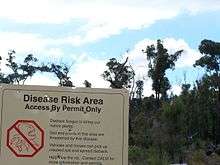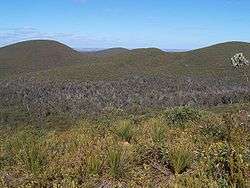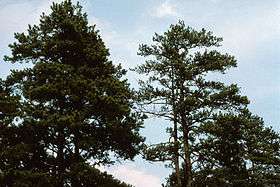Phytophthora cinnamomi
| Phytophthora cinnamomi | |
|---|---|
 | |
| Scientific classification | |
| (unranked): | SAR |
| Superphylum: | Heterokonta |
| Class: | Oomycetes |
| Order: | Pythiales |
| Family: | Pythiaceae |
| Genus: | Phytophthora |
| Species: | P. cinnamomi |
| Binomial name | |
| Phytophthora cinnamomi Rands | |
Phytophthora cinnamomi is a soil-borne water mould that produces an infection which causes a condition in plants called "root rot" or "dieback". The plant pathogen is one of the world's most invasive species and is present in over 70 countries around the world.
Life cycle and effects on plants
Phytophthora cinnamomi lives in the soil and in plant tissues, can take different shapes and can move in water.[1] During periods of harsh environmental conditions, the organisms become dormant chlamydospores. When environmental conditions are suitable, the chlamydospores germinate, producing mycelia (or hyphae) and sporangia. The sporangia ripen and release zoospores, which infect plant roots by entering the root behind the root tip. Zoospores need water to swim through the soil, therefore infection is most likely in moist soils. Mycelia grow throughout the root absorbing carbohydrates and nutrients, destroying the structure of the root tissues, "rotting" the root, and preventing the plant from absorbing water and nutrients. Sporangia and chlamydospores form on the mycelia of the infected root, and the cycle of infection continues to the next plant.
Early symptoms of infection include wilting, yellowing and retention of dried foliage and darkening of root color. Infection often leads to death of the plant, especially in dry summer conditions when plants may be water stressed.
Sexual reproduction
Phytophthora cinnamomi is a diploid and heterothallic species with two mating types, A1 and A2.[2] Sexual reproduction in heterothallic Phytophthora species ordinarily occurs when gametangia of opposite mating type interact in host tissue. This interaction leads to the formation of oospores that can survive for long periods in or outside the host. Phytophthora cinnamomi is also capable of self-fertilization (i.e. it can be homothallic). Phytophthora cinnamomi mating type A2 cultures can be induced to undergo sexual reproduction by exposure to damaging conditions, that is by exposure to hydrogen peroxide or mechanical damage.[3]
In the wild
When phytophthora dieback spreads to native plant communities, it kills many susceptible plants, resulting in a permanent decline in the biodiversity and a disruption of ecosystem processes. It can also change the composition of the forest or native plant community by increasing the number of resistant plants and reducing the number of susceptible plant species. Native animals that rely on susceptible plants for survival are reduced in numbers or are eliminated from sites infested by Phytophthora dieback.
Damage to forests suspected to be caused by Phytophthora cinnamomi was first recorded in the United States about 200 years ago. Infection is the cause of sudden death of a number of native tree species, including American chestnut, littleleaf disease of shortleaf pine (Pinus echinata), Christmas tree disease in nursery grown Fraser fir (Abies fraseri), while oaks are affected from South Carolina to Texas.

In Australia, where it is known as phytophthora dieback, dieback, jarrah dieback or cinnamon fungus,[4] Phytophthora cinnamomi infects a number of native plants,[5] causing damage to forests and removing habitats for small mammals.
Of particular concern is the infection and dieback of large areas of forest and heathland which support threatened species in the south-west corner of Western Australia. Many plants from the genera Banksia, Darwinia, Grevillea, Leucopogon, Verticordia and Xanthorrhoea are susceptible. This in turn will impact on animals reliant on these plants for food and shelter, such as the southwestern pygmy possum (Cercartetus concinnus) and the honey possum (Tarsipes rostratus).

Phytophthora cinnamomi is also a problem in the Mexican state of Colima, killing several native oak species and other susceptible vegetation in the surrounding woodlands. It is implicated in the die-off of the rare endemic shrub Ione manzanita (Arctostaphylos myrtifolia) in California, as well.[6]
In addition to damage to native woodlands, Phytophthora cinnamomi can also infect fruit trees, nut trees and other ornamental plants. Research has shown that Phytophthora cinnamomi can infect club mosses, ferns, cycads, conifers, cord rushes, grasses, lilies and a large number of species from many dicotyledonous families. This is a remarkable range for a plant pathogen and highlights the effectiveness of Phytophthora cinnamomi as an aggressive primary pathogen. The Invasive Species Specialist Group includes this species in its list of "100 of the World's Worst Invasive Alien Species".[7]
In gardens and crops
Phytophthora dieback affects a large number of common garden species, natives and horticultural crops. This list of susceptible plants includes roses, azaleas and fruit trees. Since there is no known cure, once the disease has been introduced into a garden it cannot be easily eradicated, and can become a major problem.
Protocols to prevent the disease from entering gardens include sourcing plants from non-dieback infested areas (not local bushland), using sterilised potting mixes, and using only mulch that has been properly composted. Transplanting established plants from one garden to another can also spread the disease. Propagating from seed and cuttings is less likely to transmit the disease because there is no soil transported with stock.
Many nurseries are accredited under the Nursery Industry Accreditation Scheme Australia (NIASA) and use hygienic practices to prevent Phytophthora dieback from infecting their stock. Hygienic practices prevent the spread of the disease in contaminated potting mix, plant material and water sources. Other preventative measures include raised benches, regular testing for phytophthora dieback, and the placing of new stock in quarantine.
Plants typically die from phytophthora dieback at the end of summer when the plants are under the most stress. For this reason phytophthora dieback can often be confused with symptoms of drought. Phytophthora dieback will affect a range of different susceptible plants, but will not impact on resistant plant species. If the disease is suspected, a likely mode of disease transmission should be identified. The best method to confirm the presence of the disease is testing of soil and/or plant samples by a diagnostic laboratory.
Control of existing Phytophthora infestations includes injecting or spraying plants with phosphite (a fungicide), using well-composted mulch, and using pre-planting techniques such as solarisation or biofumigation. Composted mulch is highly suppressive to phytophthora dieback and can prevent healthy plants getting infected. It is most important to prevent the spread of infected soil, plants or water. Infested areas can be revegetated or landscaped with resistant plant species which are not affected by the disease.
Impact on avocado farming
Phytophthora cinnamomi is the leading cause of damage to avocado trees, and is commonly known as "root rot" amongst avocado farmers. Since the 1940s various breeds of root rot-resistant avocados have been developed to minimize tree damage. Damaged trees generally die or become unproductive within three to five years. A 1960 study of the Fallbrook, California area correlated higher levels of avocado root rot to soils with poorer drainage and greater clay content.
Phosphite fungicide treatment
Phosphite (phosphonate) salts can be used as a biodegradable fungicide to protect plants against phytophthora dieback. It is usually applied as potassium phosphite, derived from phosphorous acid neutralized with potassium hydroxide. Calcium and magnesium phosphite may also be used. Phosphite works by boosting the plant's own natural defences and thereby allowing susceptible plants to survive within phytophthora dieback infested sites. It is important to note that there is no treatment that will eradicate phytophthora dieback, including phosphite. However, an integrated approach can successfully control the spread and impact of the disease. An integrated approach may combine strategic phosphite treatment, fumigants, controlling access, correcting drainage problems, removal of host plants and implementing excellent hygiene protocols.
Phosphite is not toxic to people or animals and its toxicity has been compared to that of table salt. There is a very low pollution risk associated with phosphite. When phosphite is sprayed on to the foliage of plants, it is applied at a very low rate, so any phosphite that reaches the soil is bound to the soil and does not reach the water table.
Phosphite needs to enter a plant's water transport system in order for it to be effective. This can be done by injecting phosphite into trees, or spraying the leaves of understorey plants. Phosphite not only protects a plant from phytophthora dieback infection, it can also help a plant to recover if it is already infected.
See also
References
- ↑ Managing Phytophthora Dieback in Bushland: A Guide for Landholders and Community Conservation Groups (PDF) (5th ed.). Australia: Dieback Working Group. 2009. ISBN 9780646493046.
- ↑ Linde C, Drenth A, Kemp GH, Wingfield MJ, von Broembsen SL (August 1997). "Population Structure of Phytophthora cinnamomi in South Africa". Phytopathology. 87 (8): 822–7. doi:10.1094/PHYTO.1997.87.8.822. PMID 18945050.
- ↑ Stimulation of sexual reproduction in Phytophthora by damage.Reeves RJ, Jackson RM Journal of General Microbiology 1974 84, 303-310
- ↑ Cinnamon Fungus. Parks Victoria. parkweb.vic.gov.au
- ↑ Groves, E.; Hollick, P.; Hardy, G.; McComb, J. "WA list of susceptible plants" (PDF). Murdoch University.
- ↑ Swiecki, T. J.; Bernhardt, E. A. (2003). "Diseases threaten the survival of Ione manzanita (Arctostaphylos myrtifolia)". Phytosphere Research.
- ↑ 100 of the World's Worst Invasive Alien Species. Global Invasive Species Database. issg.org
External links
- "Phytophthora root rot — fact sheet". Botanic Gardens Trust. Archived from the original on 7 March 2005..
- Centre for Phytophthora Science & Management. .
- Department of Environment, Water and Natural Resources, South Australia Phytophthora is killing our plants!. Retrieved 14 January 2016.
- Dieback Web Portal. .
- Dieback Working Group. .
- Australian Government Department of the Environment, Water, Heritage and the Arts Threat abatement plan for disease in natural ecosystems caused by Phytophthora cinnamomi, 2009.
- Hansen, E. Phytophthora in North American forests.
- Wills, R. T. Plant Diseases in the south-west of Western Australia – a summary.
- Zentmyer, G.A., 1980. Phytophthora cinnamomi and the Diseases it Causes, Monograph no. 10, APS Press, St Paul, Minnesota, US.
- fact sheet of the Global Invasive Species database
- Department of Environment and Conservation Western Australia. .
- List of native garden plants resistant to Dieback (Phytophthora cinnamomi) by E. Groves, G. Hardy & J. McComb, Murdoch University 2003